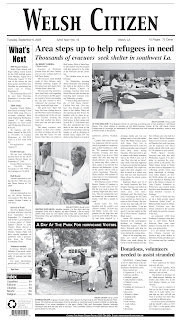On August 29, 2005, Hurrican Katrina made landfall just east of New Orleans. The following is a column from The Welsh Citizen, written by me on a Tuesday afternoon 13 years ago:
What
many feared finally happened. Hurricane Katrina, one of the worst
hurricanes ever
recorded
in this country, made landfall early Monday morning, August 29.
Katrina
didn’t seem too scary at first. She made landfall in southern
Florida as a Category 1 hurricane, went out in the Gulf and rapidly
built up power. The fearful weather front aimed at the
Louisiana coast. Was New Orleans going to get a direct hit? What
would happen? Would she take a more western path? What would then
happen with us?
The
killer hurricane hit the coast south of New Orleans but made a last
minute turn towards the east. The eye just missed the city, but was
devastating for The Big Easy’s neighbors in Mississippi and
Alabama.
On
Monday I was going to Crowley to prepare the newspaper for the press.
I went straight to Crowley fairly early in the morning because I had
no idea that to expect on I-10.
It
was weird traveling eastward that morning. Hardly no traffic at all.
I wasn’t passed by one single vehicle during the half an hour it
took me to drive over to Crowley, and I did not pass anyone up
either. I am not sure if I even saw 10-15 cars driving east or west
that morning. It was right around 7:30 a.m. and the highway is
usually busy at that time.
I
went back to Welsh but took a break at the rest area just east of
Jennings. It was crowded.
Everyone
I talked to was from New Orleans. Most of the travelers had spent the
night at the rest area. Some even put up tents. People were sleeping
on the ground; others were sitting in their cars trying to get
relatives over the cell phone.
One
doesn’t see taxi cabs from New Orleans too often in this neck of
the wood. Shah Malik was sitting in his cab
waiting,
not for passengers, but for a word from home in New Orleans.
A
school bus driver, Linda McCall from the New Orleans West Bank, had
loaded up her family in the bus to seek shelter away from the storm.
Another
family had loaded up two cars with 15 cats, eight dogs, three
ferrets, three parrots, a guinea pig, plus Smiley the Frog. They were
also from the Westbank and had not even considered getting a hotel
room. All animals were doing well and the five people seemed to do
well,
too.
A family from Slidell had loaded up the trailer with their three
dogs. They ended up near Jennings because earlier rest areas were
even busier. They also knew that they were safe from the storm.
Every
one of these individuals from all walks of life had something in
common that morning. “I want to get back as
soon
as possible to see what I have left.” They all made that comment
even if it was worded differently.
The
storm passed and New Orleans seemed to have fared as well as could be
expected. I was not the only one that took a deep breath of relief
Monday evening. On Tuesday morning news
reported
that a levee broke and water was now coming into the central parts of
New Orleans. There had been reports on Tuesday on flooded areas near
Lake Pontchartrain. I just got back from the TV set at home. I had to
drag myself away from the CNN broadcast. The coast guard was working
hard rescuing people from their flooded homes. Only the roofs were
sticking up from the water. Some structures were on fire. Looting on
Canal Street was reported. The scenes on the TV screen are almost
impossible to describe.
What
was happening to this beautiful city? I had loose plans on Monday
evening to try to take off from work get over to New Orleans. A guy
from Malmö, Sweden was stranded in a hotel and I was asked by a
Swedish newspaper if it was possible for me to get in touch with him
and other Swedish tourists for a report. That proved to be
impossible.
The
question is now – what will New Orleans be like after this? How
much demolition is there? What about the damage from the flooding?
I
hope that New Orleans can be brought back to its former beauty. I am
optimistic it is possible.
And
let’s not forget the human sacrifices. Many lives were lost. We
don’t know how
many
yet. At least not on this Tuesday afternoon.
Editor’s
note: The column
was
written on Tuesday,
September
30 and published in The Welsh Citizen on September, 6, 2005.

No comments:
Post a Comment